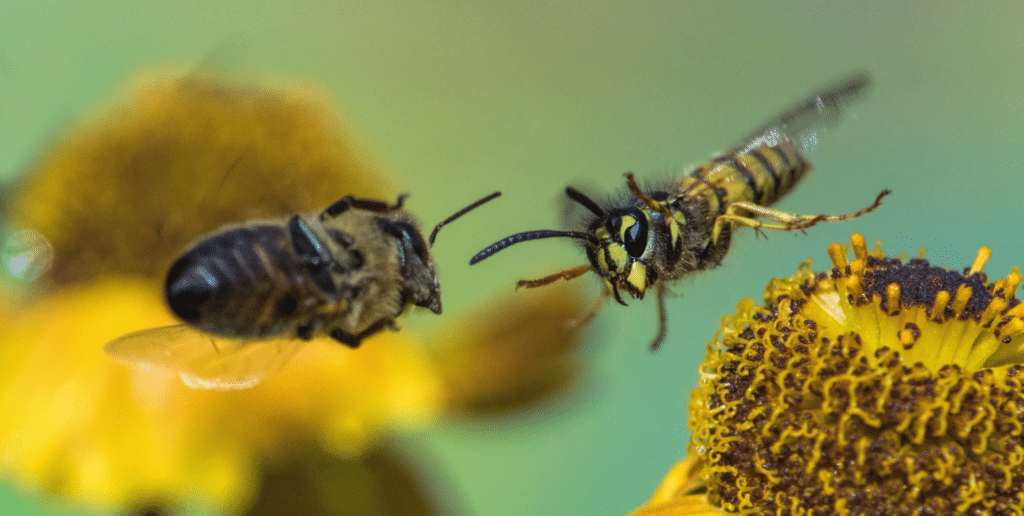July in Ireland means one thing in the pest control industry. Wasp and bee season is in full swing. We are receiving countless calls daily from customers that are dealing with these pests. And our technicians are flat out getting rid of wasps, as quickly and effectively as possible. Not many people know the difference between a wasps nest or a bee swarm. And this is why we receive so many calls about wasps when the customer has bees. Once a wasp call comes in, we can eradicate the nest within the hour. However, we cannot guarantee the same service for a bee infestation. We will discuss the many reasons for this throughout this blog post. Additionally, we will discuss how you can identify the difference between wasps and bees. So that you can ensure you are calling the correct provider to deal with your infestation.
Can a Pest Control Company Get Rid of Bees for Good?
The simple answer to this question is yes. A pest control company can get rid of a bees. However, it is not as straight forward as ringing us and we resolve the issue immediately. Bees are essential to our environment. As they are pollinators. Therefore, we will only eradicate a bee hive if there is truly no other choice. So, if you have a bee issue, your first call is to a bee keeper. They can come out and effectively remove and relocate the bees. Without harming them. However, if you cannot find a bee keeper, we can help. By trying to do everything in our power to move the bees. However, we will perform the treatment if they are aggressive. Or if they are in an area where they could hurt someone but moving them isn’t an option. Although it will be as a complete last resort.
The Physical Difference Between Wasps and Bees
Wasps and bees belong to the order Hymenoptera and share some common physical characteristics. However, there are key differences that set them apart. Firstly, wasps typically have slender bodies with a distinct narrow waist separating their thorax and abdomen. Their bodies are usually smooth and shiny. And they have longer and more slender legs compared to bees. On the other hand, bees have robust bodies covered in dense hair. Giving them a fuzzy appearance. Their legs are shorter and more adapted for carrying pollen. Secondly, wasps come in a variety of colours, including black, yellow, and metallic blue. Some species may have bright red or orange markings. Bees, on the other hand, often have a more diverse colour palette. Ranging from black and yellow to brown and even metallic green or blue. These colour variations can be helpful in distinguishing between the two.
Differences in Behaviour and Aggression Levels
Understanding the behaviour and aggression levels of wasps and bees is crucial in differentiating between the two. Wasps are often more aggressive than bees. They have the ability to sting multiple times without losing their stingers. This makes them more likely to attack when threatened. Wasps also tend to be more territorial and protective of their nests, which can be a cause for concern if they build their nests in close proximity to human dwellings. In contrast, bees are generally less aggressive and more focused on foraging for nectar and pollen. They will only sting if they feel threatened or when their hive is in danger. Bees have barbed stingers that can lodge in the skin upon stinging. Consequently leading to their death. This means that bees are more likely to avoid stinging. Unless they deem it absolutely necessary.
Nesting Habits of Wasps and Bees
The nesting habits of wasps and bees differ significantly. Wasps construct nests made of paper-like material. They create their nest by chewing wood fibres mixed with saliva. Building them in various locations. Including underground, hollow trees, and even the eaves of buildings. Some wasp species exhibit solitary behaviour. Building and inhabiting their nests alone. While others are social and live in colonies. Bees, on the other hand, build intricate nests made of wax. Honeybees, for instance, create hexagonal cells within their hives to store honey and rear their young. Bumblebees often nest in abandoned rodent burrows or in grassy areas.
In contrast to wasps, most bees are social insects that live in colonies with a queen bee leading the hive and worker bees performing various tasks. Bees tend to stick together. So seeing a large swarm together is an indication of a bee issue. Rather than a wasps nest. By observing the nesting habits of these insects, you can gain valuable insights into whether you’re dealing with wasps or bees.
Diet and Feeding Habits of Wasps and Bees
Wasps are primarily carnivorous and feed on other insects, spiders, and even small prey such as caterpillars. Some wasps scavenge for sugary substances. Such as, fruit juices and leftovers. While wasps may occasionally visit flowers for nectar, it is not their main source of sustenance. Bees, on the other hand, are herbivores and rely heavily on nectar and pollen for their nutrition. They collect nectar from flowers using their long tongues and store it in their honey stomachs for transportation back to the hive. In the process, bees inadvertently transfer pollen from one flower to another, aiding in the pollination of plants. The difference in diet and feeding habits reflects in their behaviour as well. Wasps are often hovering near food and rubbish. While bees are more commonly near flowers in search of nectar and pollen.

